Thermomechanical Processing of a Near-α Ti Matrix Composite Reinforced by TiBw
Abstract
:1. Introduction
2. Materials and Methods
3. Results and Discussion
3.1. Microstructural Characterization
3.1.1. Initial Microstructures
3.1.2. Microstructure Evolution after Heat Treatment
3.2. Tensile Properties
3.3. Fracture Toughness
3.4. Fracture Mechanism Analysis
4. Conclusions
Author Contributions
Funding
Conflicts of Interest
References
- Banerjee, D.; Williams, J.C. Perspectives on Titanium Science and Technology. Acta Mater. 2013, 61, 844–879. [Google Scholar] [CrossRef]
- Williams, J.C.; Starke, E.A., Jr. Progress in structural materials for aerospace systems. Acta Mater. 2003, 51, 5775–5799. [Google Scholar] [CrossRef]
- Gorsse, S.; Miracle, D.B. Mechanical properties of Ti-6Al-4V/TiB composites with randomly oriented and aligned TiB reinforcements. Acta Mater. 2003, 51, 2427–2442. [Google Scholar] [CrossRef]
- Guo, X.; Wang, L.; Wang, M.; Qin, J.; Di, Z.; Lu, W. Effects of degree of deformation on the microstructure. mechanical properties and texture of hybrid-reinforced titanium matrix composites. Acta Mater. 2010, 60, 2656–2667. [Google Scholar] [CrossRef]
- Wang, B.; Huang, L.J.; Geng, L.; Rong, X.D.; Liu, B.X. Effects of heat treatments on microstructure and tensile properties of as-extruded TiBw/near-α Ti composites. Mater. Des. 2015, 85, 679–686. [Google Scholar] [CrossRef]
- Chandran, R.; Panda, K.B.; Sahay, S.S. TiBw-reinforced Ti composites: Processing, properties, application prospects, and research needs. JOM 2004, 56, 42–48. [Google Scholar] [CrossRef]
- Ye, Q.; Guo, Z.M.; Bai, J.L.; Lu, B.X.; Lin, J.P. Gelcasting of titanium hydride to fabricate low-cost titanium. Rare Met. 2015, 34, 351–356. [Google Scholar] [CrossRef]
- Zhang, W.J.; Sun, X.Y.; Hui, S.X.; Ye, W.J.; Li, Y.F. α2 phase precipitation behavior and tensile properties at room temperature and 650 °C in an (α + β) titanium alloy. Rare Met. 2019. [Google Scholar] [CrossRef]
- Lü, Z.D.; Zhang, C.J.; Du, Z.X.; Han, J.C.; Zhang, S.Z.; Yang, F.; Chen, Y.Y. Relationship between microstructure and tensile properties on a near-β titanium alloy after multi-directional forging and heat treatment. Rare Met. 2018, 38, 336–342. [Google Scholar] [CrossRef]
- Zhang, R.; Wang, D.; Yuan, S. Effect of multi-directional forging on the microstructure and mechanical properties of TiBw/TA15 composite with network architecture. Mater. Des. 2017, 134, 250–258. [Google Scholar] [CrossRef]
- Zhang, C.J.; Qu, J.P.; Wu, J.; Zhang, S.Z.; Han, J.C.; Hayat, M.D.; Cao, P. A titanium composite with dual reinforcements of micrometer sized TiB and submicrometer sized Y2O3. Mater. Lett. 2018, 233, 242–245. [Google Scholar] [CrossRef]
- Hill, D.; Banerjee, R.; Huber, D. Formation of equiaxed alpha in TiB reinforced Ti alloy composites. Scr. Mater. 2005, 52, 387–392. [Google Scholar] [CrossRef]
- Rastegari, H.A.; Asgari, S.; Abbasi, S.M. Producing Ti–6Al–4V/TiC composite with good ductility by vacuum induction melting furnace and hot rolling process. Mater. Des. 2011, 32, 5010–5014. [Google Scholar] [CrossRef]
- Li, J.; Wang, L.; Qin, J.; Chen, Y.; Lu, W.; Zhang, D. Effect of TRIPLEX heat treatment on tensile properties of in situ synthesized (TiB+La2O3)/Ti composite. Mater. Sci. Eng. A 2010, 527, 5811–5817. [Google Scholar] [CrossRef]
- McEldowney, D.J.; Tamirisakandala, S.; Miracle, D.B. Heat-Treatment Effects on the Microstructure and Tensile Properties of Powder Metallurgy Ti-6Al-4V Alloys Modified with Boron. Metall. Mater. Trans. A 2010, 41, 1003–1015. [Google Scholar] [CrossRef]
- Huang, L.J.; Xu, H.Y.; Wang, B.; Zhang, Y.Z.; Geng, L. Effects of heat treatment parameters on the microstructure and mechanical properties of in situ TiBw/Ti6Al4V composite with a network architecture. Mater. Des. 2012, 36, 694–698. [Google Scholar] [CrossRef]
- Launey, M.E.; Ritchie, R.O. On the Fracture Toughness of Advanced Materials. Adv. Mater. 2010, 21, 2103–2110. [Google Scholar] [CrossRef]
- Jia, R.C.; Zeng, W.D.; He, S.T.; Gao, X.X.; Xu, J.W. The analysis of fracture toughness and fracture mechanism of Ti60 alloy under different temperatures. J. Alloy. Compd. 2019, 810, 151899. [Google Scholar] [CrossRef]
- Rack, H.J.; Qazi, J.I. Titanium alloys for biomedical applications. Mater. Sci. Eng. C 2006, 26, 1269–1277. [Google Scholar] [CrossRef]
- He, S.; Zeng, W.; Xu, J.; Chen, W. The effects of microstructure evolution on the fracture toughness of BT-25 titanium alloy during isothermal forging and subsequent heat treatment. Mater. Sci. Eng. A 2019, 745, 203–211. [Google Scholar] [CrossRef]
- Zhang, C.J.; Lian, Y.Z.; Chen, Y.F.; Sun, Y.G.; Zhang, S.Z.; Feng, H.; Zhou, Y.W.; Cao, P. Hot Deformation Behavior and Microstructure Evolution of a TiBw/Near α-Ti Composite with Fine Matrix Microstructure. Metals 2019, 9, 481. [Google Scholar] [CrossRef] [Green Version]
- Wang, B.; Huang, L.J.; Geng, L. Effects of heat treatments on the microstructure and mechanical properties of as-extruded TiBw/Ti6Al4V composites. Mater. Sci. Eng. A 2012, 558, 663–667. [Google Scholar] [CrossRef]
- Lutjering, G. Influence of Processing on Microstructure and Mechanical Properties of (α+β) Titanium Alloys. Mater. Sci. Eng. A 1998, 243, 32–45. [Google Scholar] [CrossRef]
- Cvijović-Alagić, I.; Gubeljak, N.; Rakin, M.; Cvijović, Z.; Gerić, K. Microstructural morphology effects on fracture resistance and crack tip strain distribution in Ti-6Al-4V alloy for orthopedic implants. Mater. Des. 2014, 53, 870–880. [Google Scholar] [CrossRef]
- Wang, L.; Niinomi, M.; Takahashi, S.; Hagiwara, M.; Emura, S.; Kawabei, Y.; Kim, S.J. Relationship between fracture toughness and microstructure of Ti-6Al-2Sn-4Zr-2Mo alloy reinforced with TiB particles. Mater. Sci. Eng. A 1999, 263, 319–325. [Google Scholar] [CrossRef]
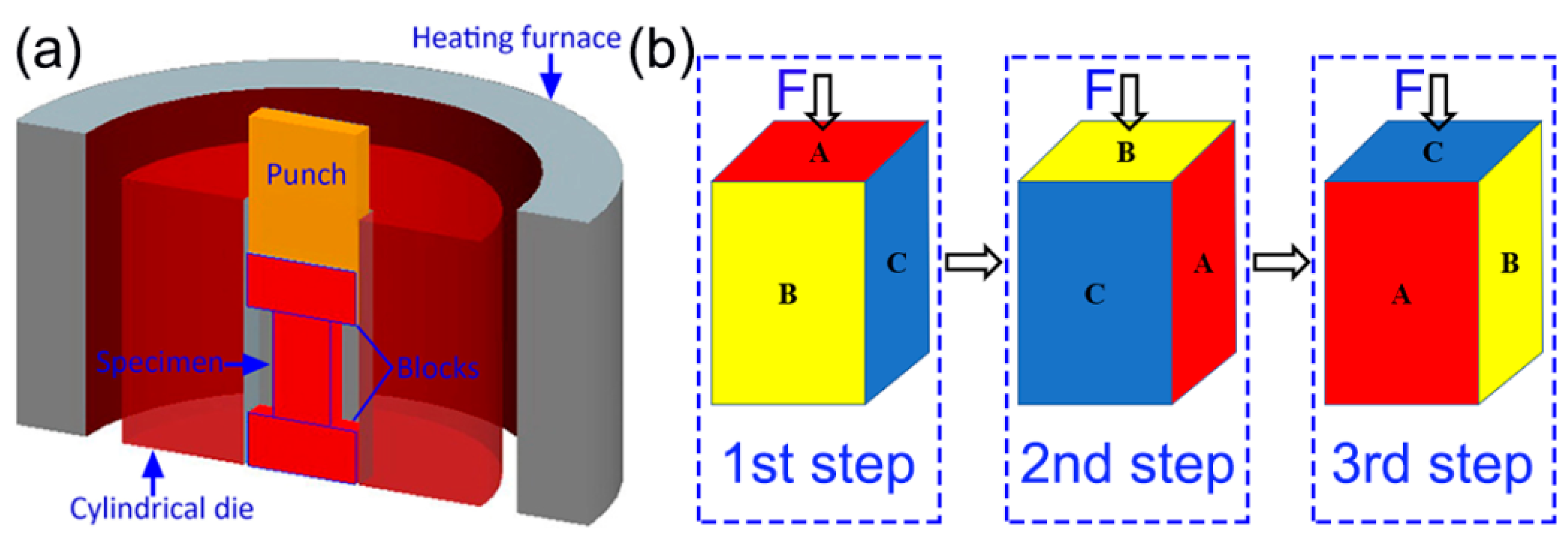
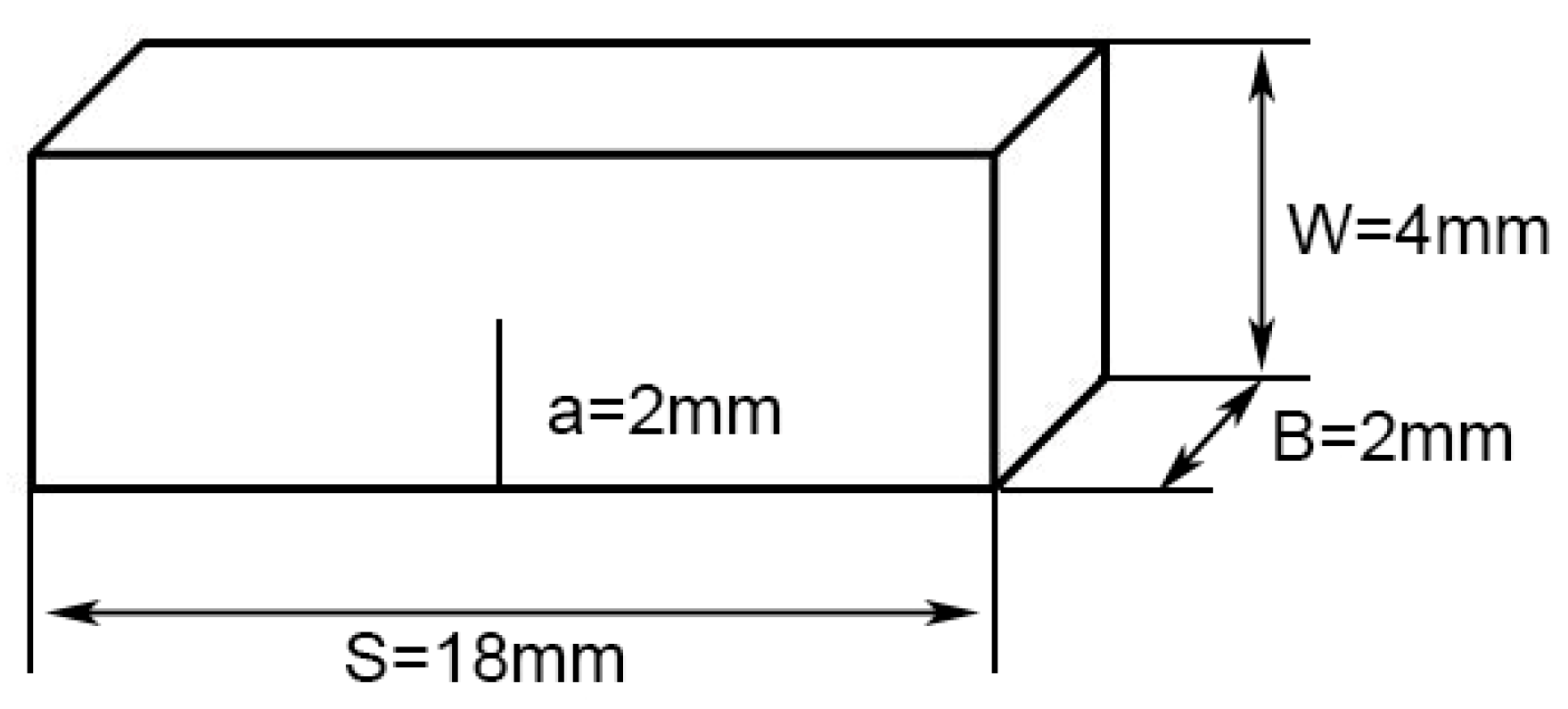


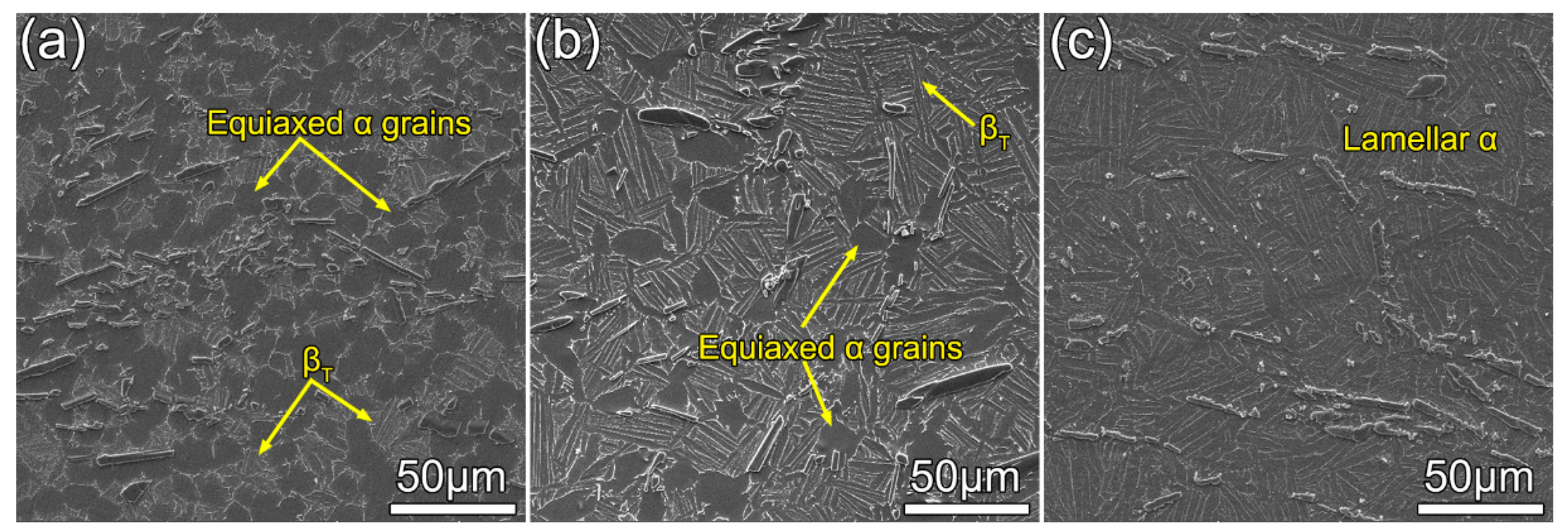
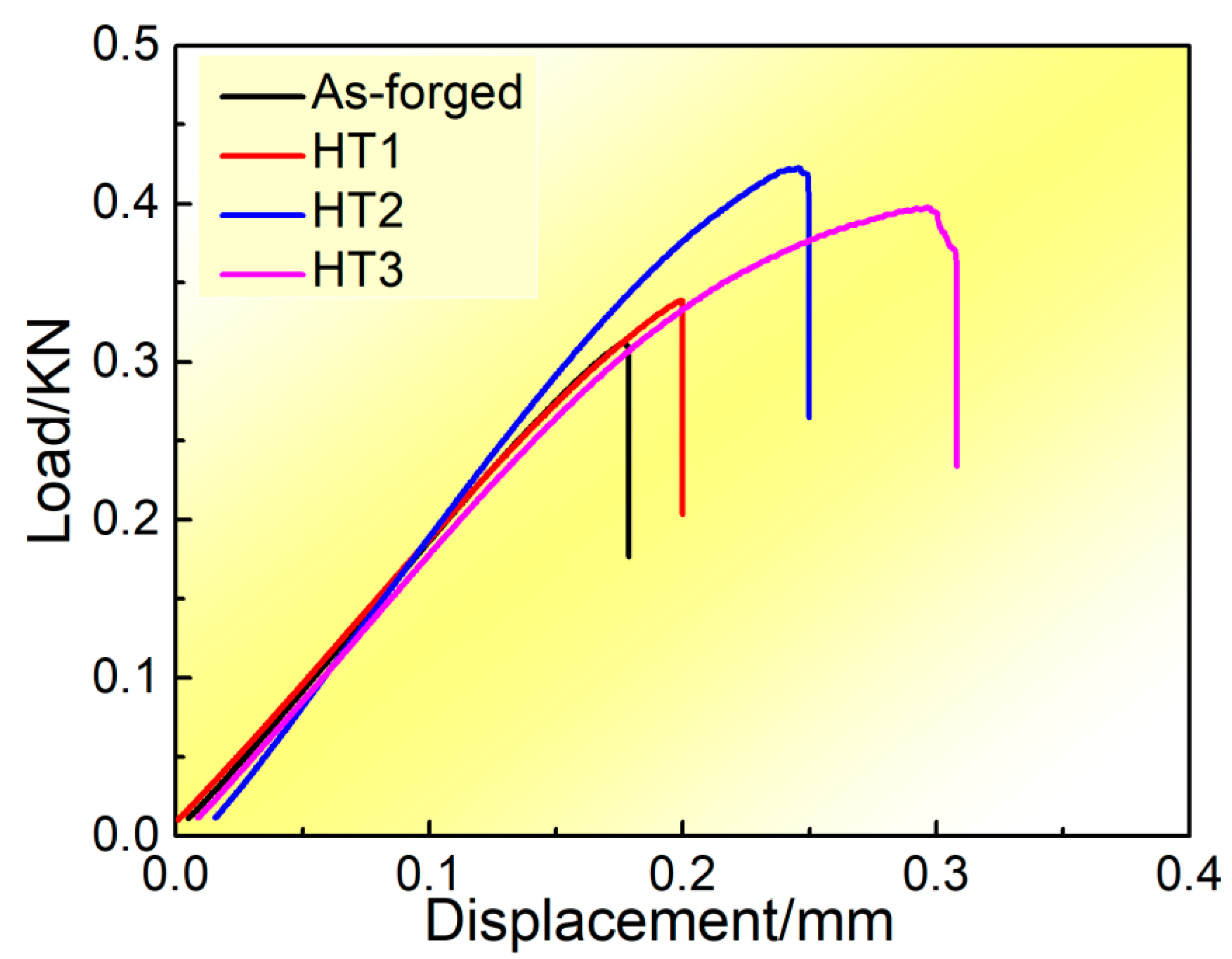
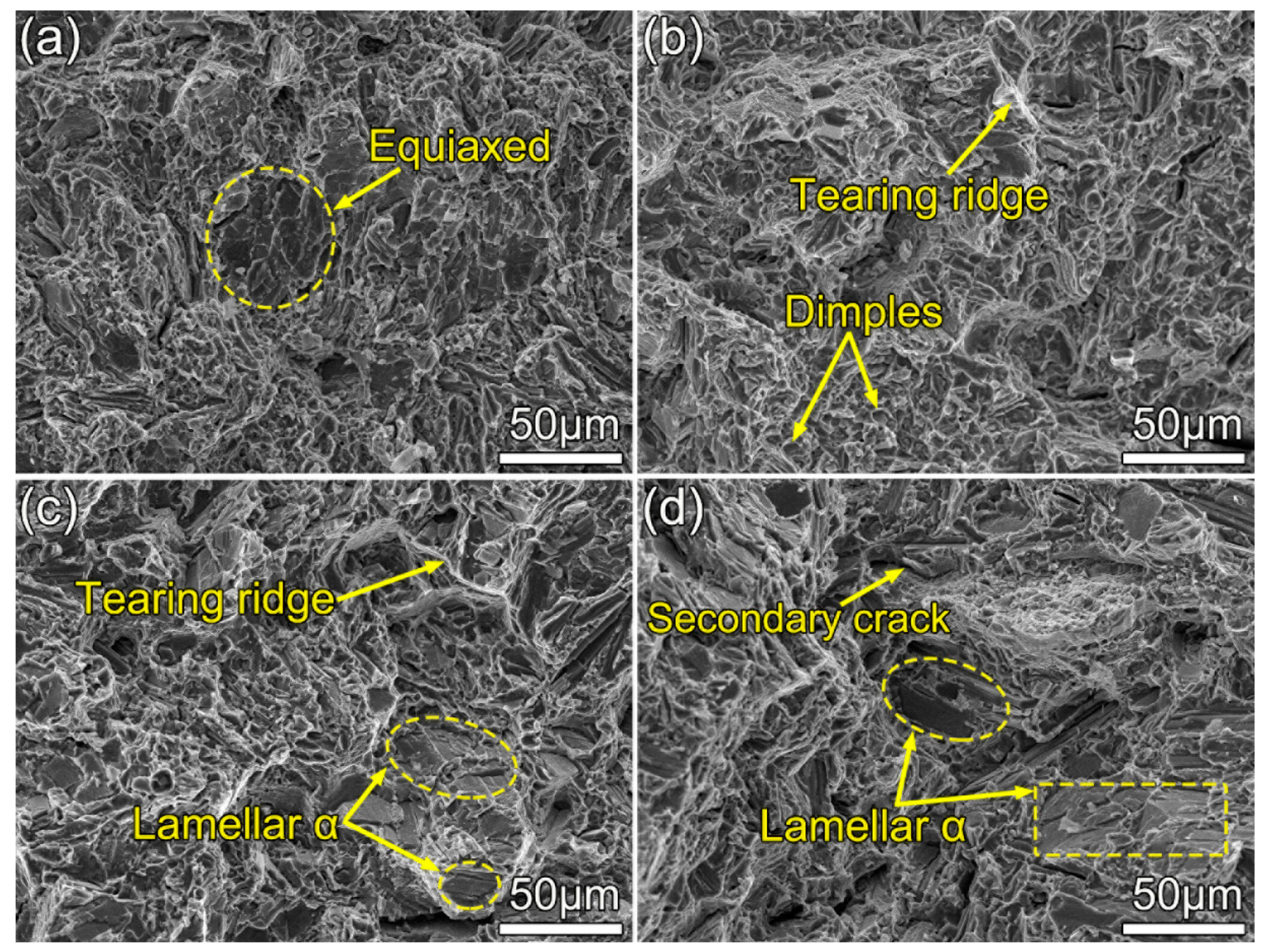


| Sample ID | Solution Treatment | Aging Treatment |
|---|---|---|
| HT1 | 975 °C/0.5 h/AC | 550 °C/6 h/AC |
| HT2 | 1000 °C/0.5 h/AC | 550 °C/6 h/AC |
| HT3 | 1025 °C/0.5 h/AC | 550 °C/6 h/AC |
| Conditions | σ0.2 (MPa) | σb (MPa) | δ (%) |
|---|---|---|---|
| As-cast | 1033.1 ± 7.5 | 1089.5 ± 8.2 | 1.31 ± 0.4 |
| As-forged | 1124.8 ± 9.4 | 1172.3 ± 10.1 | 3.97 ± 0.7 |
| HT1 | 1143.2 ± 9.8 | 1197.7 ± 10.6 | 2.85 ± 0.6 |
| HT2 | 1179.9 ± 10.2 | 1253.1 ± 12.7 | 2.48 ± 0.6 |
| HT3 | 1201.6 ± 12.1 | 1270.9 ± 13.3 | 2.17 ± 0.5 |
| Conditions | σ0.2 (MPa) | σb (MPa) | δ (%) |
|---|---|---|---|
| As-cast | 524.8 ± 2.7 | 606.0 ± 3.5 | 6.58 ± 1.2 |
| As-forged | 612.3 ± 3.2 | 687.1 ± 3.8 | 22.16 ± 3.4 |
| HT1 | 650.4 ± 3.4 | 734.9 ± 4.5 | 16.13 ± 2.2 |
| HT2 | 664.2 ± 3.8 | 769.9 ± 5.3 | 16.82 ± 2.4 |
| HT3 | 707.9 ± 4.2 | 786.0 ± 6.0 | 9.73 ± 1.9 |
| Conditions | As-Forged | HT1 | HT2 | HT3 |
|---|---|---|---|---|
| KIC (MPa·m1/2) | 47.1 | 52.0 | 54.9 | 58.5 |
Publisher’s Note: MDPI stays neutral with regard to jurisdictional claims in published maps and institutional affiliations. |
© 2020 by the authors. Licensee MDPI, Basel, Switzerland. This article is an open access article distributed under the terms and conditions of the Creative Commons Attribution (CC BY) license (http://creativecommons.org/licenses/by/4.0/).
Share and Cite
Feng, H.; Sun, Y.; Lian, Y.; Zhang, S.; Zhang, C.; Xu, Y.; Cao, P. Thermomechanical Processing of a Near-α Ti Matrix Composite Reinforced by TiBw. Materials 2020, 13, 5751. https://doi.org/10.3390/ma13245751
Feng H, Sun Y, Lian Y, Zhang S, Zhang C, Xu Y, Cao P. Thermomechanical Processing of a Near-α Ti Matrix Composite Reinforced by TiBw. Materials. 2020; 13(24):5751. https://doi.org/10.3390/ma13245751
Chicago/Turabian StyleFeng, Hong, Yonggang Sun, Yuzhou Lian, Shuzhi Zhang, Changjiang Zhang, Ying Xu, and Peng Cao. 2020. "Thermomechanical Processing of a Near-α Ti Matrix Composite Reinforced by TiBw" Materials 13, no. 24: 5751. https://doi.org/10.3390/ma13245751



_Xu.jpg)



